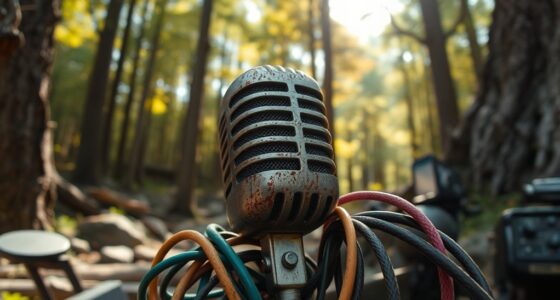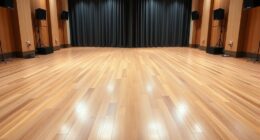Creative use of silence and space allows you to shape emotions and deepen meaning by intentionally incorporating pauses and minimalism. When you emphasize spaciousness, you guide your audience to reflect, feel tranquility, or build tension. Strategic pauses highlight key moments and give your work a natural rhythm. If you keep exploring, you’ll discover how these subtle techniques can transform your work into a more immersive and impactful experience.
Key Takeaways
- Incorporate deliberate pauses in music or speech to emphasize emotional shifts and create natural flow.
- Use minimalistic visuals with ample space to evoke tranquility and allow audience reflection.
- Employ silence strategically as a storytelling tool to highlight key moments or build tension.
- Design compositions that embrace emptiness, guiding focus on subtle details and fostering immersion.
- Balance sound and silence to engage audience imagination, enhancing emotional and cognitive connection.

Silence and space are powerful tools in creative expression, often underrated in their ability to shape meaning and emotion. When you incorporate ambient minimalism into your work, you’re intentionally stripping away clutter, allowing each sound or visual element to breathe. This approach emphasizes simplicity, creating a calm, immersive environment that invites your audience to focus on subtle details. Ambient minimalism relies on the strategic use of silence and space to evoke tranquility, introspection, or even tension, depending on how you frame it. By intentionally leaving room for the viewer or listener to fill in the gaps, you engage their imagination at a deeper level. You’re not just filling every moment with noise or visual stimuli; instead, you’re guiding them to experience the pauses and emptiness as integral parts of your message. Additionally, utilizing user-friendly interfaces in creative tools can help streamline the process of incorporating silence and space effectively. Strategic pauses are another essential element in your creative toolkit. These deliberate moments of silence can serve as punctuation, emphasizing key ideas or emotional shifts. When you pause thoughtfully, you give your audience time to process what’s just been said or shown, making the subsequent message more impactful. Pauses also create a rhythm that can build anticipation or release tension, giving your work a natural flow that feels intentional rather than rushed. You might find that a well-placed pause in a musical composition, a spoken word piece, or even a visual sequence enhances the overall experience, transforming simple sequences into powerful storytelling devices. The key is to recognize when silence can speak louder than words or images, allowing your audience to dwell in the moment rather than rushing through it.
Frequently Asked Questions
How Can Silence Improve Audience Engagement in Performances?
Silence can boost your audience’s engagement by building anticipation and highlighting emotional depth. When you pause intentionally, you give your audience space to process what’s happening, making their reactions more intense. This silence creates moments of tension and reflection, drawing them in deeper. By mastering this, you make your performance more powerful, and your audience feels more connected to the story you’re telling, heightening their overall experience.
What Are Common Mistakes When Using Space Creatively?
You often drown your work in overcrowded compositions, ignoring negative space, which can make your piece feel overwhelming. A common mistake is not balancing space intentionally, causing your audience to feel lost or disengaged. You might also clutter the scene with too many elements, losing the power of subtlety. Remember, space isn’t empty—it’s an essential tool for focus and impact, so use it wisely to create harmony and draw attention where it matters most.
How Does Cultural Context Influence the Perception of Silence?
Cultural context greatly influences how you perceive silence, as cultural interpretations shape what silence signifies. In some cultures, silence is valued as a sign of respect or contemplation, while in others, it may be seen as discomfort or disinterest. Social norms dictate how you interpret these pauses, making your perception of silence deeply rooted in cultural understanding. Being aware of these differences helps you navigate cross-cultural interactions more thoughtfully.
Can Silence Be Used Effectively in Digital or Virtual Art?
You can use silence effectively in digital or virtual art by emphasizing virtual silence, like in Jenny Holzer’s LED installations, where minimal text and space evoke reflection. This aligns with digital minimalism, reducing clutter to focus on core messages. By strategically incorporating pauses or empty spaces, you create a contemplative atmosphere that invites viewers to engage deeply, transforming silence into a powerful tool for emotional impact and meaning.
What Are Examples of Famous Works That Master Space and Silence?
Famous artworks like Mark Rothko’s color fields and James Turrell’s light installations master space and silence by creating immersive environments that evoke calm and introspection. You can see mastery examples in Agnes Martin’s minimal grid paintings, where subtlety emphasizes quietude. These works invite you to pause, reflect, and experience the profound power of silence and space, showing how art can evoke emotion through restraint and openness.
Conclusion
Think of silence and space as a garden you tend. Sometimes, you let the weeds grow quiet, giving room for the flowers to bloom fully. Other times, you step back, allowing the empty patches to breathe and invite imagination. When you master this dance, your work becomes a symphony of pauses and pauses filled with potential. Embrace the quiet moments—they’re the fertile soil where your creativity can truly flourish and bloom into something extraordinary.










